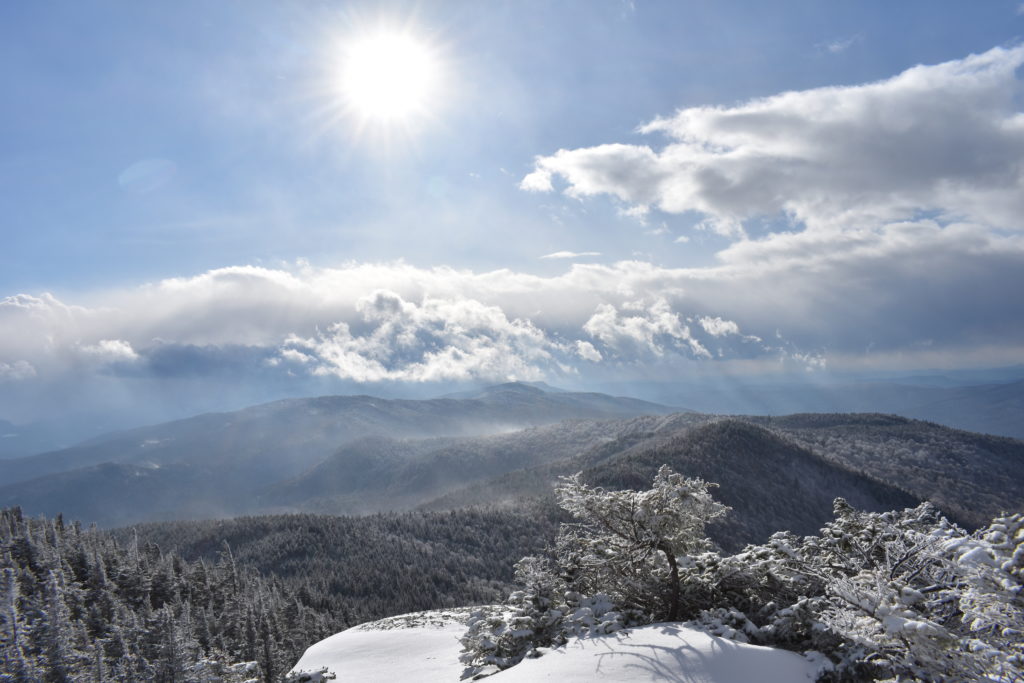
Temperatures are warming up and spring starts next week, signaling the end of winter and an upcoming mud season as snowmelt and rainfall flood trails. But Vermont’s seasons can be challenging to forecast; late snowstorms or cold snaps preserve winter conditions for a few more weeks of winter hiking. While it can be difficult to predict the official end of winter, we assure you, you still have time to get out and enjoy snow-covered trails. Here’s how:
Firstly, what is “mud season?”
Winter hiking officially ends when mud season begins. As snow melts and spring rains move in, all that water turns the trails, well, muddy. And while we’re not afraid of getting dirty, heavy traffic on trails in this condition causes lasting damage both to the trails and surrounding environments. (More on that later.) In the meantime, we strongly suggest you don’t hike when the trails are that messy.
How long can I keep winter hiking?
This depends a lot on the weather, and factors such as location, elevation, sunlight, snowpack, and rainfall will all influence trail conditions. “Snowpack usually lasts through March, so mud season usually doesn’t start until mid-April,” says GMC Volunteer & Education Coordinator Lorne Currier. There’s a silver lining: “Northern Vermont’s high-elevation mountains will keep their snow longer than southern Vermont,” says Lorne. This means while it may be mud season in Bennington, you could still have winter hiking conditions in Stowe.
“A north-facing slope will keep a strong snowpack much longer than a south-facing slope,” he adds. That also means that southern and south-facing slopes will dry out quicker and jumpstart hiking season.
You can also count on GMC and the Vermont Dept. of Forest, Parks, and Recreation for updates and recommendations.
How do I make the most of lasting winter conditions?
March tends to feature deeper snowpack than earlier winter months, making hiking paths easier to navigate. Snow is packed down, and roots and rocks are hidden underneath it for a smoother trail experience. March also brings more daylight hours than January, and more blue skies to look forward to at the summit.
“You don’t need to leave for every hike at 8 a.m., and you can plan for lengthier hikes [in March],” says Lorne. However, you should be prepared with both snowshoes and Microspikes. Because the days are heating up, that packed snow is weakened and post-holing (or falling leg-deep into soft snow) is more common. “You may find yourself suddenly sinking through up to your thigh on stretches of trail where you would normally float by on snowshoes,” he says. Post-holing is exhausting and dangerous, and it also makes the trails less usable for hikers who come after you. Fluctuating sub-zero temps can also cause exposed ice patches, so you’ll be grateful for the traction from Spikes.
You should also layer accordingly, which includes rain gear. “Warmer days mean you may get rain instead of snow. Rain will soak through to your body sooner and can increase the risk of hypothermia,” says Lorne. Expect winter conditions on Vermont’s highest and exposed peaks and pack a warm jacket, even if it’s summery in town.
Don’t forget to pack adequate fuel. Even with the proper gear to prevent post-holing, soft snow can cause build up on snowshoes or Microspikes and requires more energy to hike through. Pack snacks to replenish energy stores. We also love having hot tea or coffee while we sit at the summit, knock the snow off our gear, and soak up the sunshine.
Lastly, we recommend you store spare socks, shoes, and snacks in the car. Your feet are more likely to get wet in these conditions. Switching into warm, dry apparel and remembering that extra chocolate bar make the drive home more comfortable.
I’m ready for my late winter hike! Where do I start?
Check out our HikeVT page for winter hiking suggestions around the state, based on skill level.
- Easy winter hikes
- Moderate winter hikes
- Moderate to difficult winter hikes
- Difficult winter hikes (4,000-ft summits)
- Difficult winter hikes
If you need more information on parking areas, gear and safety, hiking with kids or dogs, or trail suggestions, check out our Winter Hiking Guide or Winter Hiking Workshop.
Additionally, if you notice trails are starting to get muddy, we suggest turning around and finding a different trail. (Avoid tiptoeing around mud puddles or hiking off trail; this causes long-term trail damage.) Lower-elevation hikes are less impacted during mud season. When in doubt, contact our virtual visitor center at (802) 244-7037 or [email protected]. Our Facebook group and Instagram pages are great resources for up-to-date information and mud season alternatives too. Summer hiking season will kick off Memorial Day weekend.



















Leave a Reply